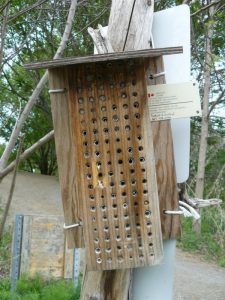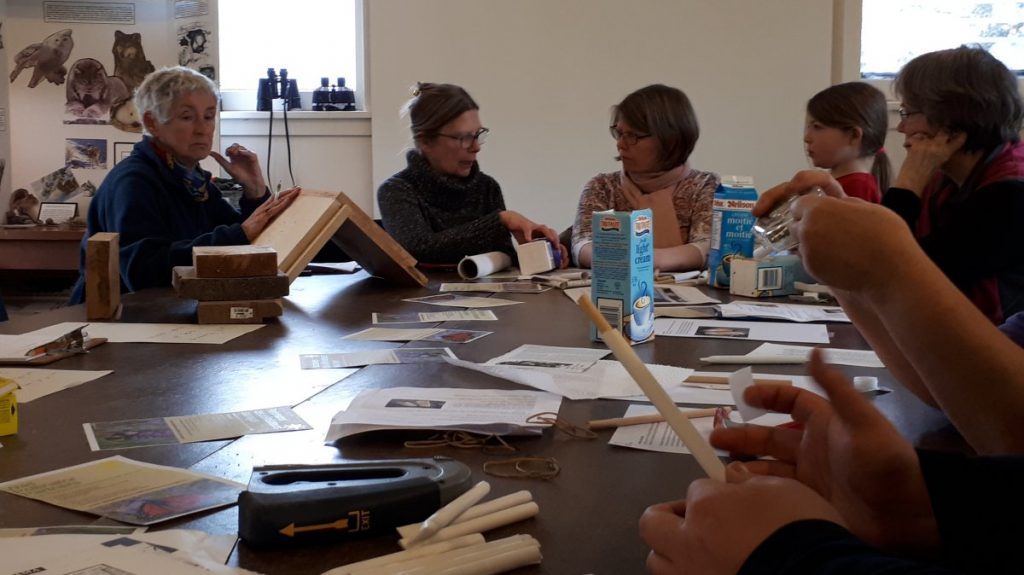by Sandy Garland
Our first events of 2018 were two workshops to build Mason Bee boxes, held on Sunday afternoons, April 8 and 15, and we couldn’t be more pleased with their success. Participants ranged over all ages and experience: keen youngsters to keen seniors, a university researcher, a farmer (who knew all the right things to do to help bees), a grandma-son-granddaughter team, gardeners, FWG volunteers, and many more.
Special thanks to Renée and Sue, who came to both workshops and helped steer people through the steps to constructing a bee box from milk cartons and used typing paper, to Renée for her knowledge and the resources she brought along, including a successful bumble bee nest box, and to Sue for taking photos.
We all learned so much from each other! I promised to try to summarize some of the knowledge and provide links to other information, including the instructions for the Mason Bee box here.
Mason Bee box

Our guaranteed-to-work Mason Bee box is made from used typing paper rolled into tubes. and bundled into 1-L cardboard cartons.
The main objective of the workshops was to make Mason Bee boxes. Why? Because we’ve had great success with these at the Fletcher Wildlife Garden and we like to recommend things that really work.
A big issue with bee boxes of any kind is keeping them clean. They should be cleaned annually to prevent the accumulation of debris and, more important, bacteria, mould, and viruses. But when should you do this? Not fall, because many tunnel-using bees are still in there, blissfully hibernating for the winter. Not spring, because as soon as last year’s bees emerge, they start laying eggs in the now vacant tunnels.
The design of our Mason Bee boxes solves this problem. Briefly:
- In April, roll tubes of used typing paper. Bundle 19 of them with an elastic, wrap with several layers of paper toweling.
- Place in a litre milk carton.
- At the beginning of May, place outside near fruit trees (and a source of mud). Please make sure the box is protected from rain, as the paper will become mouldy if wet.
- Watch.
- In early October, collect the boxes, unroll the tubes, clean off the pupae (with torpid adults inside), and put them in a aerated container in the refrigerator over winter. The tubes containing bees can be left intact and stored in a garage, shed, or other protected place over winter.
- In April, make a new Mason Bee box. This time cut a flap near the back end and put the pupae into that space.
- Go to step 3.
And here’s a video taken at the FWG in May 2016. Those are Mason Bees, looking at, entering, and leaving paper tunnels, just like the ones we made at the workshops.
A slightly different style milk carton bee nest from Pollination Guelph: Make your own milk carton bee nest
Where to put the box outside
Mount your bee box so that it is level and firmly anchored with the entrance facing east or southeast. Direct sunshine in the morning helps warm the bees up in preparation of flight.
The box should be 0.5 to 2 metres from the ground. At the FWG, we’ve had success with boxes placed in our insect hotel, about o.5 m from the ground.
This type of bee box must be protected from rain – and sprinklers – so attach it under an overhang, e.g., a deck or eave of a shed, or build a roof from wood or some other waterproof material to keep the paper from getting wet during a driving rain.
Wooden bee boxes

A well-designed, easy to clean bee box, with various sized tunnels that may be used by a number of species.
If you have access to 4″ x 4″ or 2″ x 6″ pieces of wood and a drill with a long quarter-inch bit, you might want to make a wooden bee box. To make them easy to clean, line the tunnels with parchment paper. Roll a piece of paper around a dowel or pencil, then insert into the tunnel.
It’s best to drill the tunnels all the way through the wood, then make the liner a bit too long, fold over a couple of centimetres that sticks out and cover the back of the box and those folded ends with a piece of wood that can also be used to mount the box.
In fall, take the back off the box, pull out the parchment tubes, and store them in the refrigerator (or garage or shed). In spring, make new parchment liners and put the box back out.
See also:
- Make your own wooden bee nest from Pollination Guelph
- Home made mason bee paper liners that work
Commercially available boxes
At our workshops, several people asked about and even brought along purchased bee boxes. Many of these are completely unsuitable for the bees they are meant to attract.
Tunnels should be no larger than 3/8 inch in diameter. They SHOULD be at least 6 inches long. Unless you plan to get a new box every year, the tunnels should be lined with clean paper (parchment is safest, but typing paper works).
Gardening practices
Try to include some of these pollinator-friendly features in your garden or backyard.
- Long grass, logs, brushpile – shelter for overwintering bees and other insects and places to rest or hide in summer
- Patches of bare or almost bare soil where burrowing bees can dig tunnels
- Muddy spot – some bees and wasps need mud to build their nests
- Leave the leaves – leaf litter provides winter shelter for many bees, caterpillars, and other insects. If you must tidy your lawn, rake the leaves into your garden beds
- Leave plant stems such as goldenrods, black-eyed susans, asters, cup-plants, etc., standing over the winter – certain species will use the stems of these plants to lay their eggs in
- Plant nectar rich plants – native is best, but some of the non-natives provide good nectar too
- If you need to water, use trickle or drip irrigation or a watering can for smaller areas; avoid sprinkler irrigation. Bees, especially bumble bees, sense rain coming and prepare for it, but they can’t tell when you are going to turn on your sprinkler and take shelter ahead of time.
See also:
- Habitat Network Messy gardening: pledge to be a lazy gardener
- Canadian Wildlife Federation Gardening for pollinators
Other resouces
- Pollination Guelph’s “downloads” page for great information about pollinators
- Xerces Society Pollinator conservation
Pollinator plants: northeast region - Bee and pollinator books by Heather Holm: Pollinators of native plants | Bees: an identification and native plant foraging guide
- The bees in your backyard: a guide to North America’s bees by J.S. Wilson and O.J. Messinger Carril
What’s next
Over the summer, we’re planning to organize a bunch of walks and talks. We’ll visit various pollinator sites to look for bees, see what they are doing, and note which flowers they might prefer. If the site has a bee box of any kind, we’ll check that too and try to include someone who can identify bees and tell us a bit about their life cycle and needs.
In the fall, we’ll hold a follow-up Mason Bee workshop. Every year, we put out 2 boxes at the FWG and in late September, we bring them in, unroll the tubes to see how many pupae are inside, clean them, and store them in the refrigerator over the winter. They CAN be left outside, but we gather them in to monitor the success of the boxes (and learn from experience) and to increase the likelihood of survival of the dormant bees. More about all this later in the fall.
If you attended one of the April workshops and/or made a bee box, you might want to bring yours to the fall workshop and have a look at the bees you’ve helped.
Meanwhile, we’d love to hear about the bees using your bee box. Please send photos if you can! Questions also welcome: info@wildpollinators-pollinisateurssauvages.ca
Sandy Garland is a long-time volunteer at the Fletcher Wildlife Garden. She became interested in bees and other pollinators when she built an insect hotel and, around the same time, started photographing bumble bees to submit to Bumble Bee Watch.
